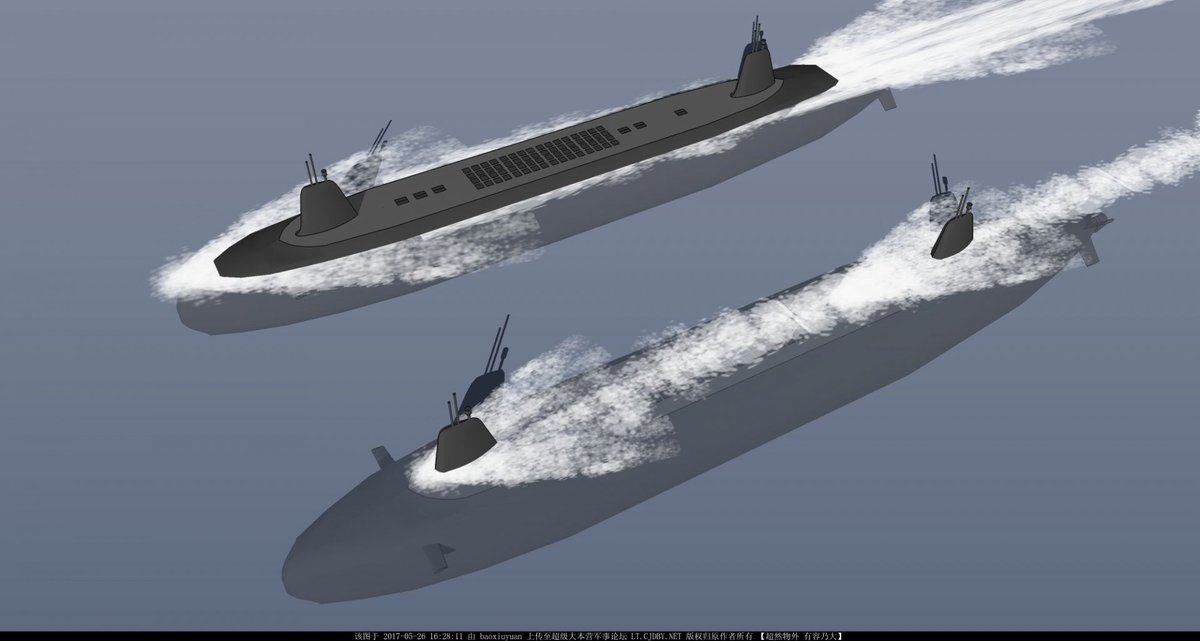Jura The idiot
General
the above goes on:
Weakly equipped with sensors, except those needed for its navigation needs, the Type 22 built more than 80 units serves mainly as launch platform for the Chinese Navy. The ship uses almost exclusively the firing parameters received from elsewhere to launch its 8 anti-ship missiles, approaching close enough to its targets like the carriers and its escort ships thanks to its carefully worked stealth."
How should it be articulated in the system of the existing systems of the Chinese navy? What is the best move for this ship? What type of propulsion - nuclear, CODOG, CODAD - will be the most suitable for its multi-mode navigation? How can he ensure that he remains "connected" to the rest of the world? What about its reliability? …etc., etc."
On the other hand, it can be reasonably assumed that a concrete warship project, or at least an experimental vessel, has been approved and gives permission to certain Chinese consultancy firms, such as the CSIC Institute 701 For example, to start officially the initial design, now that the pre-studies are a priori completed.
To be continued.
Henri K.
Appendix: This article is dedicated to my friend Daniel for his exciting explanations on the various subjects in boats and shipbuilding. A big thank-you."
"And this concept of almost "blind" weapon carrying platform is not new to the Chinese navy, in reality. The Type 22 stealth missile launcher, specially designed after the Taiwan Strait Crisis in 1996, is a typical example.Et ce concept de plateforme porteuse d’armes presque « aveugle » n’est pas nouveau pour la marine chinoise, en réalité. Le patrouilleur lance-missile furtif Type 22, conçu spécialement après la crise du détroit de Taïwan en 1996, est un exemple typique.
Faiblement équipé en capteurs, sauf ceux nécessaires pour ses besoins de navigation, le Type 22 construit à plus de 80 exemplaires sert principalement comme plateforme de lancement pour la marine chinoise. Le navire utilise quasi-exclusivement les paramètres de tir reçus d’ailleurs pour lancer ses 8 missiles anti-navires, en s’approchant suffisamment près de ses cibles comme les porte-avions et ses navires d’escorte grâce à sa furtivité soigneusement travaillée.
Weakly equipped with sensors, except those needed for its navigation needs, the Type 22 built more than 80 units serves mainly as launch platform for the Chinese Navy. The ship uses almost exclusively the firing parameters received from elsewhere to launch its 8 anti-ship missiles, approaching close enough to its targets like the carriers and its escort ships thanks to its carefully worked stealth."
"Of course, there are still many questions about this type of semi-submersible concept, if in addition it is used in the same way as the starting Arsenal ship.Bien entendu, il reste encore de nombreuses interrogations sur ce type de concept semi-submersible, si en plus il est utilisé de la même manière que l’Arsenal ship du départ.
Comment il doit s’articuler dans le système des systèmes existants de la marine chinoise ? Quel est le meilleur déplacement pour ce navire ? Quel type de propulsion – nucléaire, CODOG, CODAD – sera le plus adapté à ses multi-modes de navigation ? Comment peut-il s’assurer de rester « connecté » aux restants du monde ? Quid de sa fiabilité ? …etc…etc.
How should it be articulated in the system of the existing systems of the Chinese navy? What is the best move for this ship? What type of propulsion - nuclear, CODOG, CODAD - will be the most suitable for its multi-mode navigation? How can he ensure that he remains "connected" to the rest of the world? What about its reliability? …etc., etc."
"Whatever the case, if the project really exists, it also makes one think of the semi-submersible frigate of 3 000 tons drawn by Erbil SERTER in the 90's. And given the progress of the studies and the few dates that are known to date, it is hardly conceivable that the Chinese shipyards have already started the construction of such a semi-submersible Arsenal ship as some media claim, China as elsewhere.Quoiqu’il en soit, si le projet existe réellement, il fait aussi penser à la frégate semi-submersible de 3 000 tonnes dessinée par Erbil SERTER dans les années 90′. Et compte tenu de la progression des études et les quelques dates que l’on connait à ce jour, il est peu envisageable que les chantiers navals chinois aient déjà démarré la construction d’un tel Arsenal ship semi-submersible comme prétendent certains médias, en Chine comme ailleurs.
On peut, en revanche, raisonnablement penser qu’un projet concret de navire de guerre, ou du moins un navire expérimental, ait été approuvé et qui donne l’autorisation à certains bureaux d’études chinois, comme l’Institut 701 du groupe CSIC par exemple, de démarrer officiellement la conception initiale, maintenant que les pré-études sont à priori terminées.
A suivre.
Henri K.
Annexe : Cet article est dédié à mon ami Daniel pour ses explications passionnantes sur les différents sujets en bateaux et construction navale. Un grand merci.
On the other hand, it can be reasonably assumed that a concrete warship project, or at least an experimental vessel, has been approved and gives permission to certain Chinese consultancy firms, such as the CSIC Institute 701 For example, to start officially the initial design, now that the pre-studies are a priori completed.
To be continued.
Henri K.
Appendix: This article is dedicated to my friend Daniel for his exciting explanations on the various subjects in boats and shipbuilding. A big thank-you."






